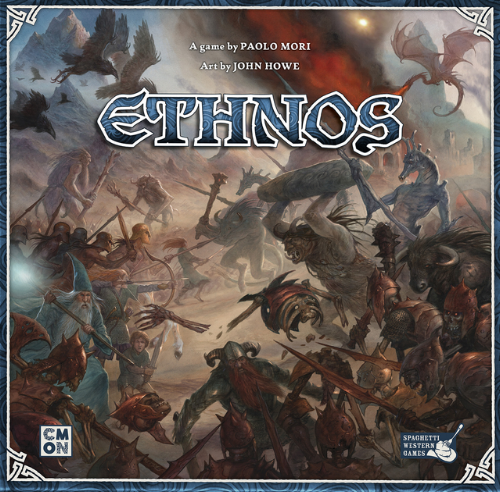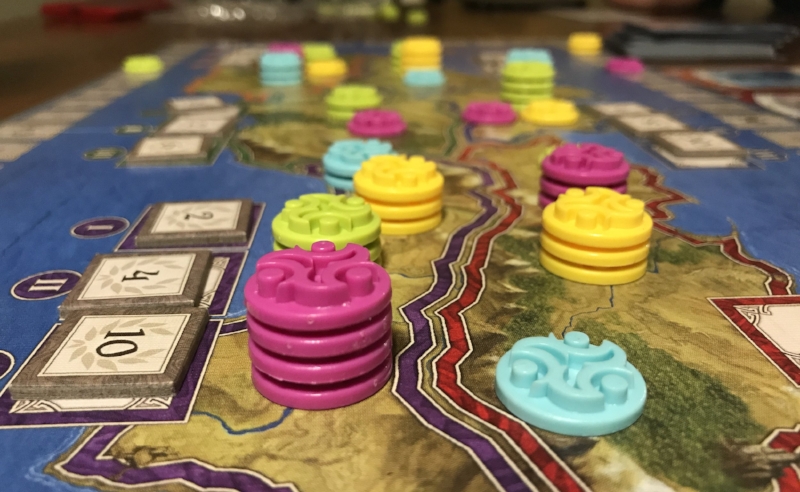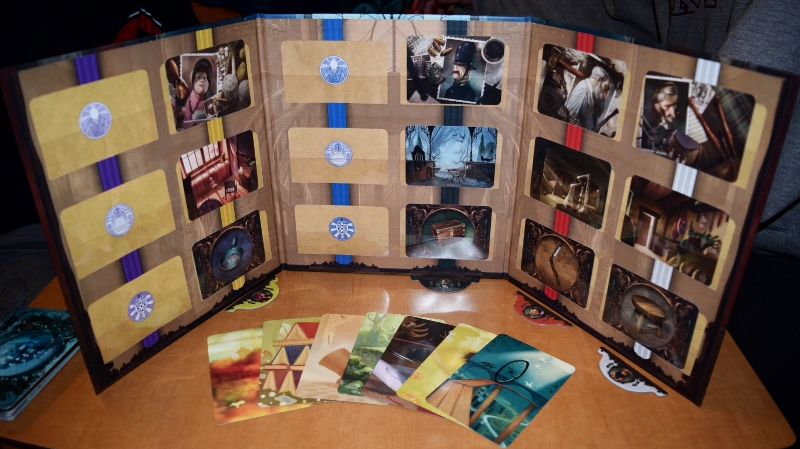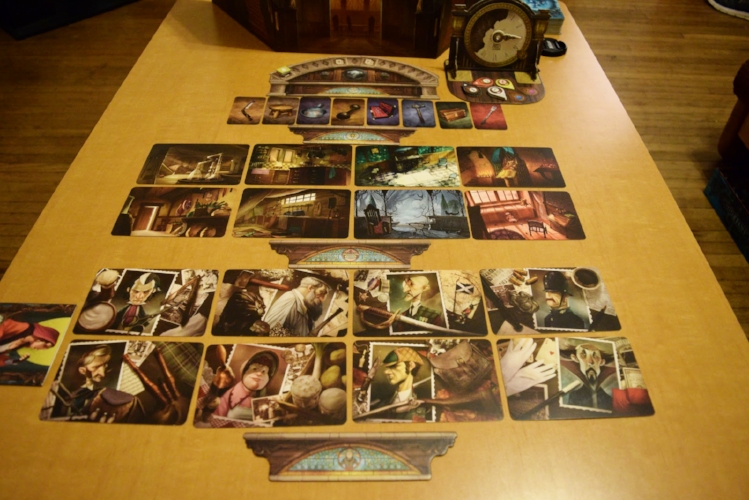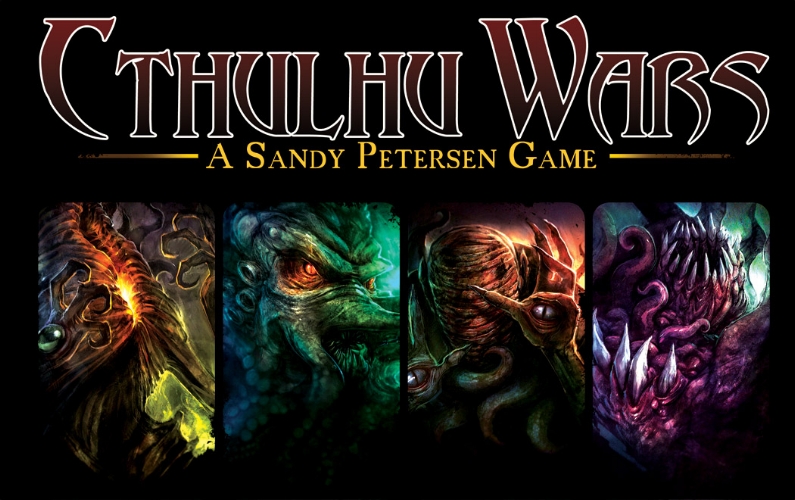Ethnos
Designed by Paolo Mori
Art by John Howe
Published by CMON Limited - 2017
2-6 players ~ 45-60 minutes
Review by Jack Eddy
There are covers, remixes, and mashups; and none of them are easy. Stick too close to the source material, and you’re just needlessly rehashing the past; stray too far away and it becomes unrecognizable, defeating the point in the first place. But the best of ‘em use your very relationship to the original artist, genre, and even period as a means to judo-flip your expectations on their head, letting you enjoy both the new AND old song in a brand new way. This is exactly what Ethnos attempts to do, using the enormous baggage of high-fantasy, area control genre conventions as a means to subvert everything you thought you knew, and it’s awesome.
How to win friends and influence nations:
Ethnos is a fantasy area control game in which players wrestle for dominion over a mystical land. Based on that sentence, what comes to mind? Sculpted miniatures? Dice rolling? Civilization Management? Hours of slogging contemplation only to end in a pyrrhic victory and hurt feelings? Ethnos is a wonderfully elegant, fast-playing abstract game that is simultaneously aggressive and welcoming; basically the opposite of what you’d expect from the box.
Over three ages (rounds), players will use a shared pool of cards to form bands of warriors and influence territories. As each round concludes, they’ll earn points by having the most influence in the various territories and for the size of the bands they’ve played.
To start, randomly pick 6 of the 12 fantasy races to form the draw deck; these will also determine which (if any) extra boards or components will come into play. Players each get one card to start, a market of face up cards is revealed, and the remaining forms the draw pile. Oh, and don’t forget to shuffle in the 3 dragon cards into the bottom half of the deck (more on that later).
And the first age begins! On a player’s turn they may either draw a card (either from the deck or face up market) or play a “band” of cards from their hand, discarding your remaining cards to the market. Bands consist of one or more cards that are either all from the same province (color) or all of the same race. Furthermore, one of the cards must be selected as the “band leader”, which determines which racial ability and which province you are influencing. If the number of cards in your band exceeds the number of influence discs you have in a region, you add a new disc.
Play continues until *GHASP* someone drew a dragon! This signals the beginning of the end of all things. Once three dragons have been revealed, the age is over and players immediately discard their hands and count points. You’ll feel a thrilling desperation as you decide whether to play the cards you have, or push your luck and try to keep drawing, knowing full well that a third dragon could be right around the corner.
This continues for three rounds (two in a 2-3 player game), with the draw deck being reformed at the beginning of each age. While your bands go away, your stacked influence discs remain in like miniature obelisks constructed in your honor; which is important because the regions become more valuable with each new age. There’s a nice ark to Ethnos as you’ll likely be playing bigger, badder bands as the game goes on, further driving the tension and desperation as the third dragon of the third age draws near*. Finally, at the end of the three rounds, points are awarded and a winner is declared.
*coincidentally, “Third Dragon of the Third Age” is the name of my new prog-metal band
How it Feels:
At first glance, Ethnos’ simplicity may be mistaken as a 1 way ticket to dullsville, but in practice it is such an exciting and fresh take on the genre. First and foremost, it solves the “Take that!” problem many people have with area control games. By making players compete over the most influence rather than attacking one another’s pieces, it completely changes the tone of the game; Ethnos is not a battle, it’s a race.
And that’s exactly how it feels! It plays at a breakneck speed. With only a handful of choices at your disposal, you usually know exactly what you want to do on your turn as soon as it comes up… that is unless your awful friends, decide to take that faceup Troll you were after. You care about what players do, what cards they take, what they leave behind, and how they have the audacity to come into YOUR territory! But at the same time, everyone is thrilled when players influence the board so they can feast on the new cards in the market, like wild dogs hungry for scraps.
Again, this anticipation and excitement betrays the plodding thoughtfulness you’d expect out of a “fantasy area control” game. Though it rewards cunning and strategic play, there may be several turns in a row where players blindly draw cards off the top of the deck, hoping against hope to draw ANYTHING that matches another card in their hands. In a lesser game this would feel like a luck-fest, but even bad draws have the versatility to shift your focus, conquering different regions, making otherwise forgotten cards in the market more valuable, or employing the powers of races you had previously dismissed. In Ethnos, you use every part of the board game buffalo.
The Art / Theme:
Let’s get this out of the way, from the archetypical fantasy races to the iconic John Howe artwork, Ethnos looks and feels like it’s set in Middle Earth, exactly like a type of game that it is not. This old school style of hand-drawn fantasy art may be a turnoff to some people, but personally I’m crazy for it. There is something fresh, cool, even challenging about decking out such a modern take on the genre with artwork in such a traditional style. Contrasted with the bizarrely gorgeous influence discs, featuring a completely different palette of hyper-tropical colors, you can’t help but awe in Howe’s mastery of the craft.
As for how the theme resonates? That may be a different story. I can do some creative reasoning as to why each race has it’s ability, but Ethnos is absolutely an abstract game. You don’t feel like you are battling opponents, you don’t feel like you are at some vast entmoot arguing over wars, you feel like you are playing cards and bright plastic disks to gain points. But in a way, this lets players engage with the theme on whatever level they want. Fans of rich fantasy worlds have an evocative land to imagine cultures rising and falling over hundreds of years; and those that roll their eyes when they hear names like “Gil-Galad” and “Bombadil” can focus purely on the strategic elements of the game, not getting hit over the head constantly by high fantasy nonsense.
Versatility / Replayability:
One interesting thing is how well it accommodates different player counts. Since the size of the deck is fixed, the game still moves at about the same pace at 2 players as it does with 6. Lower player counts tend to feel more tense and strategic, focussed on the individual plays, whereas higher player counts feel more explosive and desperate as there could be 5 players risking a dragon between now and your next turn. And while it may seem more reliant on luck, a higher player count means more hands being dumped into the market, broadening options and distracting everyone from that nasty, dragon-filled deck.
As to how it holds up after time; I am still so hungry to play this game again and again. First off, it straddles the line between light and mid-weight very well, making it an easy go-to game as either a main event or opener; but the biggest reason I come back to Ethnos is how dynamically the races interact and change the feel of each game. Like building a sandwich, the core concept of Ethnos remains consistent, but you get wildly different flavor combinations with each ingredient thrown in. Almost every game I’ve played has seen a different race as the session’s MVP, largely because players underestimated their power from previous games.
Here, at the end of all things:
There are a lot of things that Ethnos is not; It is not heavy, it is not deeply thematic, and it is not a game of war. Yet in an act of defiance, it is still an absolutely fresh and compelling take on fantasy area control games. Whether by intent of the designer or through happy accident, Ethnos dissects a stale genre and completely upends our expectations, both reminding us why we loved our old favorites while still delivering something new.
Who should get this game: Fans of classic fantasy artwork, people who like shorter games, people who love(d) area control games but their group doesn’t like “take-that”, people who delight in simple yet clever systems
Who shouldn’t get this game: People who want to fight, people who dislike luck, people who crave deep strategy, people who hate fun

